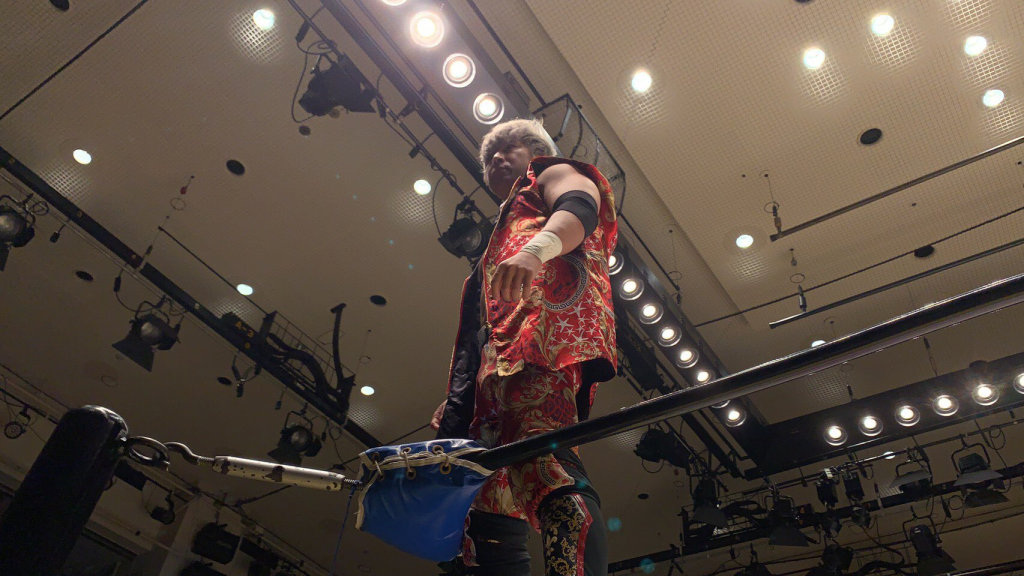
“Weird underdog charisma”
Cagematch comments are not a place to spend too much time, unless you want to find yourself in an imagined argument with someone whose self-assured opinion contradicts everything you understand about your favourite wrestler. But every now and again, something, however painful, rings true. For me, it’s the comment about Haoh’s “weird underdog charisma” that hits at something authentic, albeit not quite as I would phrase it.
Haoh, by some cagematch accounts, is a perennial loser. His character has become the inverse of his name “Haoh”, sometimes translated as “overlord” or “high king”. Formerly the fall guy for faction Kongo in NOAH, he’s also “criminally underrated”, someone fighting for a place at the table denied him because of his size and style. Losing has become a pattern and, although his position as the ‘fall guy’ clearly frustrates some of his fans, the comment about his underdog charisma also suggests that losing has become an integral part of his character. Even his moveset as Haoh nods at being the guy you don’t expect to win.
Loss and losing is an essential part of wrestling. It’s part of compelling struggles retold a thousand different ways. Even our favourites need to lose. After all, who doesn’t love a redemption arc? The fine balance between frustration at a talented wrestler losing and joy in rooting for the charismatic underdog is, for me, part of the emotional highs and lows of wrestling that I love so much.
That said, with Haoh particularly, I feel that frustration in loss. Not all losses are the same. There are losses we can accept and others we can’t. There needs to be meaning in loss, something that advances their struggle or someone else’s.
I am writing this article in the aftermath of a big loss for Haoh. The kind of loss that is a turning point. Facing Tadasuke in a ‘loser leaves NOAH’ match on 23 June 2022, Haoh was defeated and must leave the company. The loss came just a few short weeks after declaring himself the face of the juniors and winning the right to keep his name (and his hair) from his former tag team partner, Nioh (now returned to Hi69/Hirooki). The tears Haoh cried in the ring after his loss to Tadasuke looked genuine and painful. Despite Haoh’s frequent losses in NOAH, many believed he would win.
“Loser leaves…” is an established formula in puroresu, often with one ending leading to a new beginning. Finding the meaning in this type of loss is certainly possible, at least when we know what that new beginning might be. Haoh’s career as a loser is filled with other similar recognisable match formulas where, in retrospect, the meaning in loss is apparent. Since we don’t yet know exactly the meaning of this most recent match, I’m revisiting some of those previous matches to explore the value of those formulas and to take some comfort that there can, eventually, be meaning in loss.
#1: Master Vs Pupil
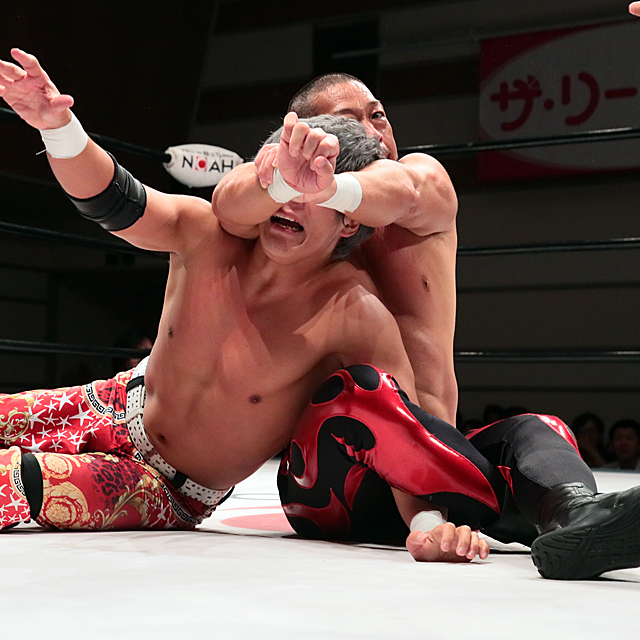
Not there yet, son: Haoh v Dick Togo, Global Junior League, 10th January 2020.
We start with Haoh’s very first singles match in NOAH under his new name, just a few days after a failed title challenge by Haoh and tag partner Nioh for the GHC Junior Tag Team Championships. The Global Junior League was an ideal opportunity for Haoh to regain some momentum and show fans who he is as a singles wrestler.
His opponent was his trainer and mentor, Dick Togo, making a surprise appearance for rival faction Sugiura-gun. Haoh made his debut alongside Daisuke Sasaki and Yusuke Kubo for Togo’s Super Crew training school in 2005. Togo has shown up throughout Haoh’s career, with his other incarnations as Yuki Sato and Kenbai also having faced and (more often than not) been defeated by the man who trained him.
Depending on the outcome, the master vs pupil formula can act as a lesson that there is further to go or it can be a passing of a torch. In victory or loss, it connects a wrestler to their history and, through emphasising an association, can confer some of the status of an experienced and established talent on a more junior wrestler. In this case, it brought attention to Haoh in his new incarnation, giving him the opportunity to showcase his skills and give his audience an insight into his character.
Haoh starts off the match aggressive, not waiting for Togo to remove his vest but immediately hitting him with a dropkick and then a tope con hilo on the outside. This gives us a glimpse of the Haoh that fans will get to know over the next two years; quick, impulsive and with a willingness to throw himself at opponents with little hesitation. The strikes are stiff, with vicious slaps that seem unfeasible for Hoah’s stature. Haoh shows his depth of feeling, with Togo certainly not going easy on his former pupil. We learn not to read weakness into Haoh’s smaller stature.
As Togo turns the match to his advantage, we get to see a side of Haoh that will become even more familiar; Haoh fighting repeatedly from his knees as he refuses to submit. We see Haoh the opportunist, very nearly successfully reversing Togo’s inside cradle, and Haoh the determined, clawing his way to the ropes from Togo’s crossface. Ultimately we also see Haoh the loser, as Togo hits his diving senton and keeps Haoh down after just 9 minutes.
For fans unfamiliar with Haoh’s previous incarnations, the match is a perfect introduction to that strange underdog charisma they will come to recognise. For those more familiar with his prior characters in Yuki Sato or Kenbai, this match shows the breaks and the continuity, establishing that this version of Togo’s trainee has not adopted Togo’s swagger and memorable heel tactics in the same way as Yuki Sato had in Kaientai.
The match itself is short but, despite some restrictions around video distribution for the show, was streamed live on NOAH’s twitter account, reflecting the level of interest in Togo, Haoh and the master vs pupil formula. The focus it puts on Haoh is important at a time when he could have faded into the background after his failed tag championship challenge. It lets fans (and other wrestlers – his next opponent Tadasuke is in the audience too) learn what they can expect from this new addition to the junior division.
Haoh finishes the tournament with only one win of a possible three in his block, beating Tadasuke, but is not weakened in the process. Togo goes on to the final, eventually losing to a fired-up Daisuke Harada. A loss to a senior and eventual finalist is the kind of loss that can be accepted. Instead of being a limitation on Haoh, the match is a showcase, linking Haoh’s past and future in a recognisable formula. It serves as a transition into NOAH and a place from which to build.
#2 The Test
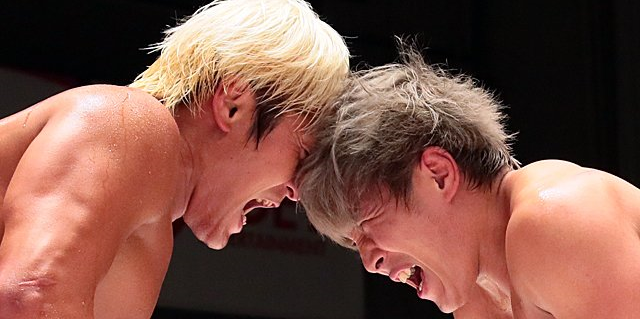
Loss to light a flame: Haoh vs Kenoh, Kongo Produce DIAMOND 2, 24th July 2020 and Haoh vs Nioh, Kongo Produce DIAMOND 3, 26th December 2020.
One of the reasons I love these matches – against faction leader Kenoh at Diamond 2 in July 2020 and against tag partner Nioh at Diamond 3 in December 2020 – is because there is absolutely no reason they have to exist. But they do. I thank the wonderful logic of produce shows and Kenoh’s vision for that. Both end in violent and crushing defeat for Haoh. And yet they give him exactly what he does not get in his multiple defeats in tag matches as part of NOAH’s usual calendar: time, space and the trust that he can and will do more. In this, they are a test of how far he can go. There is no trickery, no interference, no other story at play. Haoh loses only when every other possibility is exhausted. We get a glimpse of the high king, his self-belief and the belief of his teammates. They might be losses but they serve to tell some of Haoh’s story in Kongo and in NOAH and reveal other possibilities for Haoh, for Kenoh and for Nioh along the way.
Although in many ways the same, these matches serve two different purposes. The first is a challenge to Haoh – a test to dig deeper and find his path. The second is a challenge to Nioh – to prove he can surpass his teammate and stand by himself. Both progress a story because Haoh loses.
The ‘test’ formula to matches is a common one – it lies behind the trial series that many wrestlers undertake and can be the basis of rivalries between an established talent and younger challengers. Test matches can also pit allies against each other, enabling participants to demonstrate both their skills and their bond as they use their knowledge of each other to go further than other opponents might, relying on their mutual trust.
The first of these matches, against Kenoh, is a response to a direct request from Haoh to prove himself. Kenoh and Haoh have a long history. Haoh, as Kenbai, has been Kenoh’s follower in Michinoku Pro for years. They competed together in Noah’s Junior Tag League in 2011, earning a title shot. Haoh, of course, is different from Kenbai. But all the more reason why he should need to show Kenoh his strong belief as a member of Kongo.
This is, mostly, Kenoh’s match. His stronger attacks leave Haoh sprawled on the mat clutching his ribs or crawling to his knees. But it isn’t just the defeat of a junior by a stronger heavyweight. This is Kenoh giving Haoh what he asked for and Haoh taking what he can from it.
Kenoh’s attacks are relentless. He follows up every pin attempt with another attack. He doesn’t expect Haoh to give up. When Haoh doesn’t get up immediately from the mat, he screams at him. His attacks are brutal, focused more on wearing Haoh down than taking a victory. Haoh wanted a test. This is a test.
Kenoh drags him around by his hair, screaming in his face, goading him. Haoh’s strikes back are weak, ineffective. He finds that his advantage comes in using his size and speed. Quick roll-ups, evasive manoeuvres, dropkicks in quick succession. Kenoh’s brutality rubs off on Haoh, grabbing Kenoh’s hair and biting at his head, slapping Kenoh as he rises from a pinfall. They go back and forth, raising the stakes, though it’s clear it’s Kenoh who knows how high the bar can go.
This is a match held in the midst of Coronavirus restrictions. Korakuen Hall has only a few scattered seats filled by masked faces. When Haoh fails to land the Firebird Splash the sound of his body hitting the mat echoes around the hall to a crushing silence. The two men in the ring seem oblivious to the few eyes watching them, lost as they are in destroying each other. A kick to the side of the head and a rare Dragon Suplex from Kenoh ends it. Haoh is defeated. What more could he have done?
Kongo gather round, Kenoh affirming their strength and determination. There is no weakness here. Not even in Haoh, leaning between Inamura, Nioh and the ropes to stand. And after a match that tough, who would doubt their resolve?
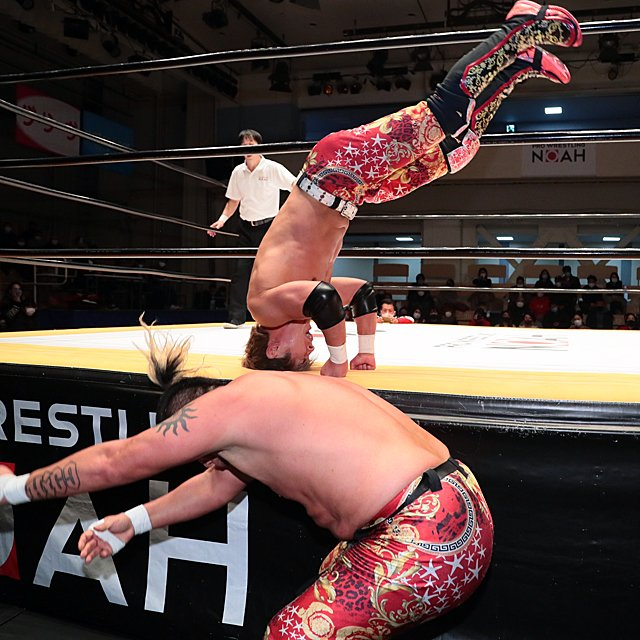
When Haoh faces Nioh five months later in December 2020, he has had a title match for the GHC Junior Heavyweight Championship and, despite losing, is in a stronger position than tag partner Nioh, who hasn’t even challenged. Nioh has taken a string of losses for Kongo and is in need of a chance to refocus. Who better than his teammate to provide that opportunity?
In some ways, the larger and more experienced Nioh should be the obvious choice to win but it is Haoh who is the more established singles competitor, despite his losses. The match is a test of both men’s resolve and of the strength of their team, given that they have so far failed to capture the GHC Junior Tag belts.
This match is intense. Brutal and intimate in an entirely different way to Haoh’s match with Kenoh, neither man holds anything back. Nioh is the first to make clear that there will be no boundaries in this match, landing a heavy slap on Haoh’s face as he pushes him back against the ropes. Haoh responds in kind without hesitation. It becomes clear that Nioh is fully prepared to meet Haoh where he is, as it is Nioh, not Haoh, who lands the first tope to the outside, crushing Haoh against the steel barrier. Their gestures and choice of moves would usually be marks of disrespect were we not aware that they are teammates. They hurt each other in the way only those truly close to each other can do, working with the security that all can be worked out tomorrow.
Nioh’s initial advantage gives way to Haoh’s determination and recklessness. Yet again, being the underdog fuels Haoh’s offence. Nioh’s aggression rubs off on Haoh and the two exchange brutal slaps in the centre of the ring that take both of them to their knees. But Haoh’s determination rubs off on Nioh. In a far more populated Korakuen Hall than five months previous, Haoh lands the firebird splash he missed on Kenoh, only to have Nioh kick out.
Nioh’s offence is heavier. The DDT he hits Haoh with on the apron is devastating. It doesn’t end Haoh immediately, both continuing to exchange kicks, strikes and aerial manoeuvres, but Nioh has what he needs to win now – his own strength and the lesson of Haoh’s determination.
When the match is finished, Nioh drags Haoh to his feet, seemingly seeking a handshake. Haoh slaps him around the face. Hard. Haoh’s determination does not die so easily. Nioh stumbles away, leaning on the ropes as he recovers. He returns to Haoh, forcibly grasping his hand and shaking it – a thank you – before returning the slap with his other hand, showing he gets the message. Haoh has lost, but his determination has not.
#3 Hope for the underdog
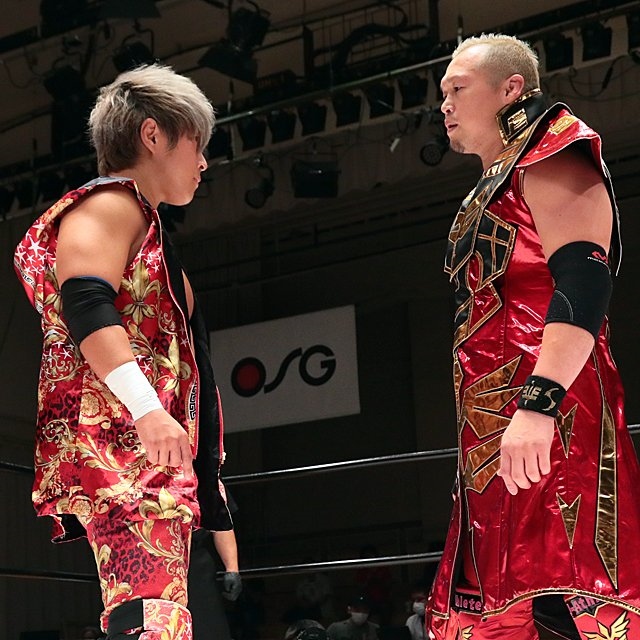
The weakest challenger? Haoh vs Kotaro Suzuki (GHC Junior Heavyweight Championship), N1 Victory, 11th Oct 2020.
It took nearly a month for Kotaro Suzuki to even accept Haoh as his challenger for the GHC Junior Heavyweight Championship. He quickly dubbed Haoh “the weakest challenger”. Suzuki was speaking from experience – he beat Kenoh and Kenbai in 2011 alongside Atsushi Aoki, and then Haoh and Nioh in 2020 alongside Atsushi Kotoge, both matches for the GHC Junior Tag Championships. He is a contender to occupy the position of Haoh’s final boss in NOAH. Despite Haoh’s underdog position and Suzuki’s clear disdain, Haoh pinning Suzuki directly in the last two matches before their title clash raised the question that fuels the suspense in so many seemingly predictable matches “is there hope?”
The use of hope underlies so many wrestling matches but in a match where there seems like a clear winner, it’s almost essential. It’s a formula that Haoh particularly has needed and its lack has been the source of frustration for his fans. This match and its build up delivered that hope and, in doing so, managed to stand out on a crowded stage.
In the match Suzuki appears to have the upper hand from the outset, absorbing Haoh’s aggression easily. It seems like he will be able to patiently wear down his opponent. But, as time goes on, it doesn’t quite work that way. Haoh is resilient, determined and resourceful. Kotaro’s confidence starts to waver. Haoh somehow manages to reverse Suzuki’s attacks again and again. Mid-way through the match, we see Suzuki staring at the referee in disbelief at another close pin from Haoh. This match is not the easy victory Suzuki predicted and, as he becomes more desperate, it’s possible to believe in another outcome.
Haoh’s moves and aggression offer callbacks to his match with Kenoh, drawing on the skills that give him an advantage; speed, opportunism and a refusal to lie down. Like his match with Togo, this offers him a showcase against someone who does not see him as a threat and he pulls out all the stops. Suzuki’s position as champion seems to really be under threat. Close fall follows close fall, the stakes getting higher every time until Suzuki finally ends it, looking considerably more shaken than he anticipated. The weakest challenger has pushed him close to his limits.
The match was held on the final night of the N1 victory 2020. The card saw the newly reunited Momo no Seishun Tag recapture the junior tag belts and a final match between Kiyomiya and Nakajima that brought Nakajima to face the tag partner he betrayed in Go Shiozaki. This match could and should have been overshadowed by the quality of the card and the emotional drama. The result was predictable. Haoh was the weakest challenger. But the match itself was a triumph. The increasing investment of the crowd alongside Suzuki shows just how much we want to believe, even when we don’t expect. A win for the power of underdog charisma.
The loss of meaning?
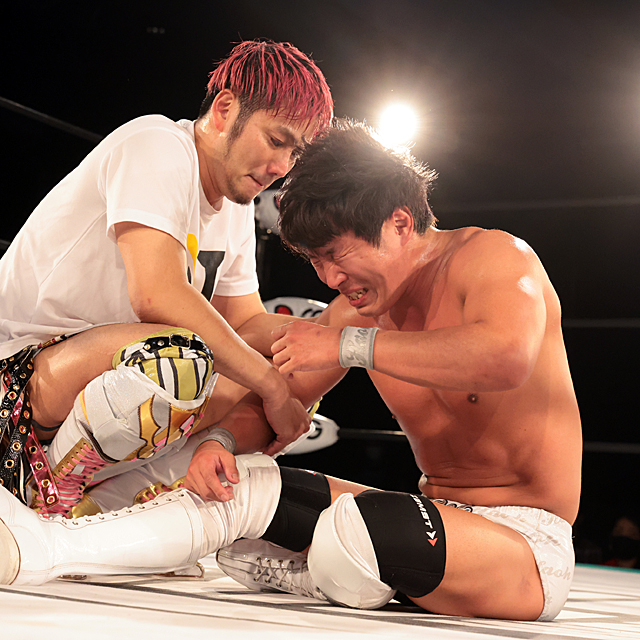
These matches show just how much power Haoh’s “strange underdog charisma” can have and how it has been built through his interactions with others. They show some of the good that can come from a loss, even for the loser. For me, the journey of writing this article also shone a light on why I had grown frustrated with Haoh’s losses in 2021 – they sometimes didn’t mean much. Without hope, or history, or challenge, they felt confusing or just irrelevant. Not everyone can be a winner, nor should we only value winners, but meaning can and should be found in both victory and defeat.
I’m excited by the possibilities of meaning offered by Haoh’s recent defeat. Will he reappear in NOAH in a new incarnation or perhaps a previous one? Or in Michinoku Pro, now that Fujita ‘Jr’ Hayato has returned and the man who defeated Kenbai in his last match, MUSASHI, is no longer champion? Could he join his ‘brother’ Daisuke Sasaki in DDT? Or ‘dad’ Togo in NJPW? Will he return to Makai or 2AW or AJPW??? Whatever is next for Haoh, I know he’ll make it mean something.
